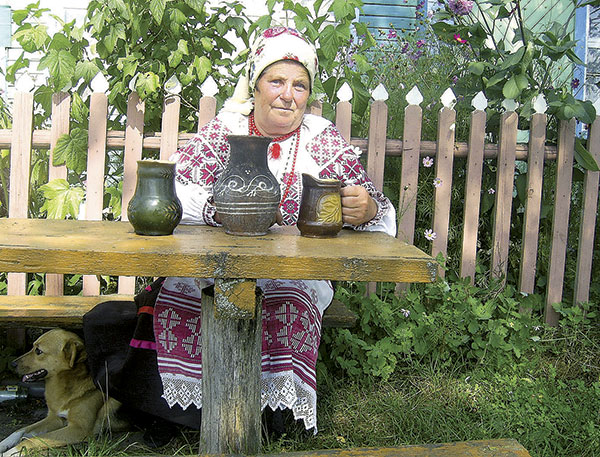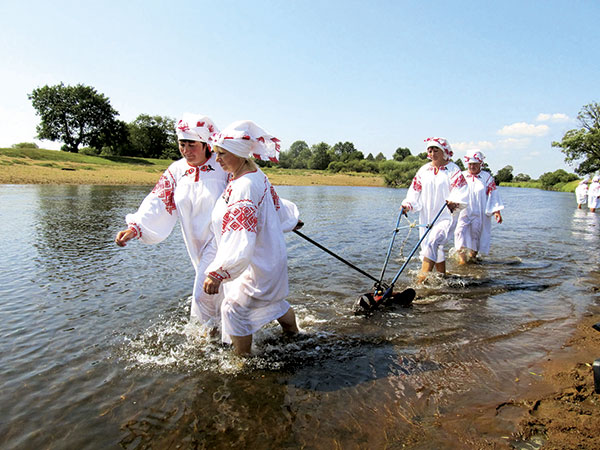
A memorial sign is situated as you enter Stary Dedin, inscribed on a black boulder. It states that ‘one of the most ancient coin treasures of Belarus was discovered here, dating from between 980 and 985’. Found in June 1926, by local villager Trofim Gudkov, the coins were concealed within two clay pots, found while ploughing.
Belaruskaya Veska (Belarusian Village) newspaper wrote of the discovery, and the Academy of Sciences sent specialists to investigate it. They were amazed to discover Cufic dirhems, a Byzantium miliarisium and two German denariuses. The coins were taken to a Minsk museum but disappeared during the Great Patriotic War (or soon after its end). Not a single coin remains at the Klimovichi District Local History Museum either, but head curator Natalia Banyshevskaya notes, “We tell tourists and local villagers of the treasure and of Stary Dedin. Actually, the village is known not only for its coins, as it enjoys unique traditions and masters. Pieces made by local potters and coopers are highly coveted in the Mogilev District.”
Stary Dedin’s senior citizens are proud of their village is history. Local wisdom says that a certain local cooper, who died at the age of 25, made his pots and barrels from ancient bog oak, gathering from along the banks of the Oster River (the Sozh basin). In lying in water, the wood blackened and became stronger, allowing barrels, butts and woodenware to remain as strong as stone, and durable. They enjoyed great demand.
Meanwhile, local potters’ designs were unique, being strong, with a spot design. Pots, including makotras (cone-shaped pots), which were made from clay, were found 10-15km away. People used to walk to collect it, and every family had its own potter. Their method of batch and firing was also unique. Villagers sold their wares in the markets of Krichev, Khotimsk and Kostyukovichi and in the neighbouring Shumyachi District: not for money but in exchange for grain. Their price was as much as the pot could contain.
Dancing village
Sadly, no potters remain in the village these days and all the pottery wheels have gone. Just 167 people live in Stary Dedin, which used to have a school and a post office. Local traditions continue though, as Galina Brykova tells us. She founded Stary Dedin’s Ostryanka People’s folk group. She explains, “There was a time when at least ten people lived in each house. Weddings were celebrated by all village residents and festivities lasted for at least three days. Those wedding were great, attracting more than 200 guests. Spring was also ‘summoned’, with the help of certain songs and harmonica accompaniment. Other villages came along and people were taught dancing and singing from childhood, so that everybody could join in.”
At the age of 74, Galina knows no less than a hundred local folk songs and can still dance the quadrille, korobochka, pas d’Espagne, cracovienne, dosada and stradaniya. “Ignore the fact that some of these dance names are sad. Dosada [translated as vexation] is a merry dance: a quick stomp. We bring authentic songs and dances to festivals, winning awards, and are proud that our children can sing and dance. We have our own children’s exemplary ensemble: Ostryanochka,” she explains.
The Deputy Director of Klimovichi’s District Culture Centre, Igor Prokhorenko, confirms Galina’s words, saying, “Our Stary Dedin grannies are truly famous. They toured half of the Soviet Union in the past. Ethnographers from Leningrad visited them, so that they could publish songbooks and a monograph on folk dances, based on our authentic material. They also released a CD. Although our ‘artistes’ are 60-80 years old, they participate in all regional festivals, also touring neighbouring Russia.”

‘River ploughing’
Village pensioners are also known for the ancient pagan custom of ‘river ploughing’, which is thought to successfully summon rainfall. Ms. Brykova explains, “On hot days, after work in the fields, our mothers and grandmothers used to ask the river to produce rain. Rain was needed, to avoid the harvests becoming too dry. They’d take the plough to the river, and it would rain the same day or the next. We’ve taken up the baton!”
Village women entered the water waist-deep, naked, with two dragging the plough, followed by another two who would hurry them along with willow branches, as the others sang certain songs.
Tatiana Skotskaya, 66, smiles, recalling, “Of course, we don’t plough the river naked now, as so many come to observe our custom! Most are Russians and Belarusians, coming in August, especially for the Saviour of Honey Feast Day. Our land is rich in wonderful healing springs. One is so deep that it hasn’t been measured; unsurprisingly, it’s called the Bottomless Well.”
The custom enters the list of intangible historical-cultural treasures of Belarus, which would bring even more tourists to Stary Dedin: a village lost somewhere between Belarus and Russia. Local residents are pleased, asserting, “Our village will live on!”
By Olga Kislyak











